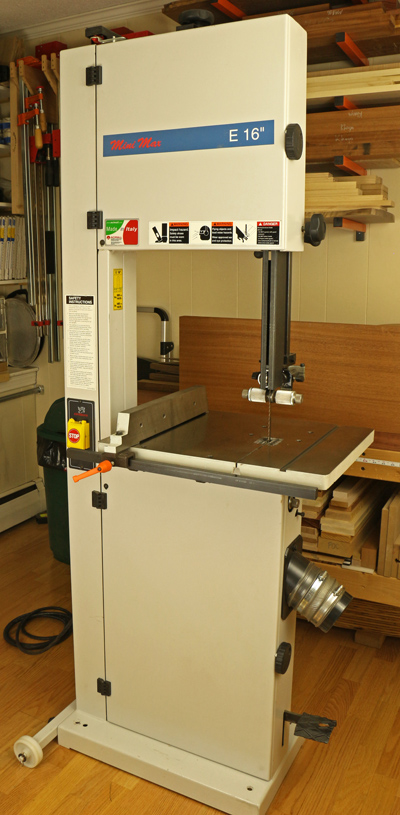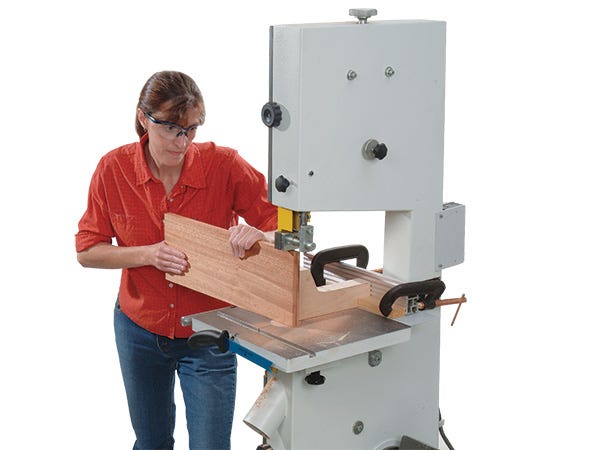So you’re in the market for a bandsaw, huh? Well, let me tell you, finding the right size can be a bit tricky. But don’t worry, I’ve got your back! In this article, we’ll dive into the question that’s been on your mind: “How big of a bandsaw do I need?”
Now, before we go any further, let me quickly explain what a bandsaw is for all the beginners out there. A bandsaw is a powerful tool used for cutting various materials, such as wood, metal, or plastic. It consists of a continuous band of toothed metal that runs on a pair of wheels, allowing for precise and efficient cuts.
Now, let’s tackle the big question: “How big of a bandsaw do I need?” The size of a bandsaw is determined by two main factors: the throat capacity and the depth of cut. The throat capacity refers to the distance between the blade and the vertical frame of the bandsaw. On the other hand, the depth of cut refers to the maximum thickness of material that can be cut with the bandsaw. Finding the right size bandsaw depends on the type of work you plan on doing and the materials you’ll be cutting. So, let’s dig deeper and find the perfect bandsaw size for you!
Choosing the right size bandsaw depends on your needs. Here’s a step-by-step guide to help you determine how big of a bandsaw you need:
- Assess your typical woodworking projects and the maximum size of material you work with.
- Consider the throat width, which determines how wide the bandsaw blade can cut.
- Look at the depth of cut, indicating the maximum height of stock the bandsaw can handle.
- Factor in the motor power for smooth and efficient cutting.
- Consider the available space in your workshop for the bandsaw.
By following these steps, you can determine the ideal size of bandsaw for your woodworking needs.

How Big of a Bandsaw Do I Need?
In the world of woodworking, a bandsaw is a versatile and essential tool. It allows you to make intricate cuts, rip lumber, and resaw thick boards. However, when it comes to choosing the right bandsaw, size matters. How big of a bandsaw do you need? In this article, we’ll explore the factors to consider when determining the ideal size of a bandsaw for your woodworking projects.
Factors to Consider
Choosing the right size of a bandsaw depends on several factors, including the type of projects you’ll be working on, the materials you’ll be cutting, and your available space. Let’s dive into these factors in more detail:
Type of Projects
The type of projects you plan to undertake will have a significant impact on the size of the bandsaw you need. If you mainly work on small-scale projects like jewelry boxes or intricate wood carvings, a compact bandsaw with a smaller throat depth and narrower blade will serve you well. On the other hand, if you frequently tackle larger projects such as furniture making or resawing thick boards, a larger bandsaw with a deeper throat depth and more powerful motor will be necessary.
Benefits of a Larger Bandsaw
Investing in a larger bandsaw has several advantages. Firstly, it allows you to work with larger pieces of wood, enabling you to tackle more ambitious projects. A larger bandsaw also offers greater cutting capacity, allowing you to resaw thick boards into thinner pieces or make intricate curved cuts. The added power of a larger motor ensures smooth and accurate cuts, even through dense hardwoods. Additionally, a larger bandsaw often comes with more advanced features and improved stability, enhancing the overall performance and versatility of the machine.
Choosing the Right Blade Size
Alongside the size of the bandsaw itself, the blade size is also a crucial consideration. The width and teeth-per-inch (TPI) of the blade will determine the precision and versatility of your cuts. For detailed work, a narrower blade with a higher TPI is preferred, allowing for intricate curved cuts. On the other hand, if you frequently work with thicker stock, a wider blade with a lower TPI will be more suitable for resawing and ripping.
Tips for Maximizing Space
If space is limited in your workshop, there are a few tips to consider when choosing the size of your bandsaw. Firstly, opt for a benchtop or compact floor-standing model that offers a smaller footprint without sacrificing cutting capacity. Another option is to select a bandsaw with a space-saving design, such as a foldable table or a mobile base that can be easily moved when not in use. Additionally, consider utilizing vertical storage or wall-mounting systems to free up floor space and keep your workspace organized.
Bandsaw Selection Guide
Now that we’ve explored the factors to consider when determining the size of a bandsaw, let’s dive into a selection guide to help you choose the perfect bandsaw for your woodworking needs:
1. Determine Your Project Scope
Consider the size and complexity of the projects you plan to tackle. Will you primarily work on smaller-scale projects or larger, more substantial pieces?
2. Assess Your Material Requirements
Think about the types of materials you’ll be cutting and their thickness. Do you frequently work with thick hardwoods or primarily use thinner stock?
3. Evaluate Available Space
Measure the space in your workshop or garage to ensure you choose a bandsaw that fits comfortably without restricting your ability to move and work around the machine.
4. Consider Blade Options
Research the blade width and TPI options available for each bandsaw model you’re considering. Ensure they align with the types of cuts you’ll be making.
5. Read Reviews and Compare Features
Take the time to read reviews from other woodworkers and compare the features and specifications of different bandsaw models. This will help you make an informed decision.
6. Set a Budget
Determine your budget range and find a bandsaw that offers the right balance between price and features. Remember, investing in a high-quality bandsaw is a worthwhile long-term investment.
7. Test Before Buying
If possible, visit a local woodworking store or attend trade shows to test out different bandsaws. Get a feel for their performance, ease of use, and overall build quality.
8. Consult with Experts
If you’re still unsure about the right bandsaw size for your needs, don’t hesitate to consult with knowledgeable woodworking experts or seek advice from online woodworking communities. They can offer valuable insights and personal recommendations.
By considering your project scope, material requirements, space limitations, and blade options, you can confidently determine how big of a bandsaw you need. Remember to choose a bandsaw that aligns with your woodworking goals and provides room for growth as you tackle more challenging projects. Happy woodworking!
Key Takeaways: How Big of a Bandsaw Do I Need?
- A bandsaw size depends on the type and size of materials you want to cut.
- A 14-inch bandsaw is a good choice for most woodworking projects.
- If you plan to work with larger materials, consider a 17-inch or 18-inch bandsaw.
- Smaller bandsaws, like 9-inch or 10-inch, are suitable for light-duty tasks or limited workspace.
- Consider the throat size and resaw capacity of the bandsaw to determine its suitability for your projects.
Frequently Asked Questions
Looking to invest in a bandsaw but not sure how big or small it should be? We’ve got you covered! Check out these frequently asked questions to help you determine the right size of bandsaw for your needs.
1. What factors should I consider when determining the size of a bandsaw I need?
When deciding on the size of a bandsaw, there are a few key factors to keep in mind:
First, think about the type of woodworking projects you’ll be working on. If you primarily work on small-scale projects, a smaller bandsaw might be sufficient. However, if you plan on tackling larger projects or cutting thick stock, a larger bandsaw with greater cutting capacity would be more suitable.
Additionally, consider the space you have available in your workshop. A bigger bandsaw will require more floor space, so make sure you have enough room to accommodate it without sacrificing maneuverability or safety.
2. How can I determine the cutting capacity I need for a bandsaw?
The cutting capacity of a bandsaw refers to the maximum width and height of material it can effectively cut. To determine the cutting capacity you need, consider the following:
Think about the types of materials you will be working with. If you plan on cutting thicker boards or large logs, you will need a bandsaw with a higher cutting capacity to accommodate those sizes. On the other hand, if you typically work with thinner materials, a smaller cutting capacity may suffice.
Keep in mind that it’s always better to have some extra cutting capacity than to be restricted by the size of the bandsaw. Opt for a bandsaw with a slightly larger cutting capacity to allow for future projects that may require larger materials.
3. Is it better to go for a larger bandsaw even if I primarily work on smaller projects?
While it may be tempting to invest in a larger bandsaw to have more versatility, it’s important to consider your specific needs and limitations. If you primarily work on smaller projects, a larger bandsaw may not be the most efficient choice.
A larger bandsaw will take up more space in your workshop, consume more powerful electrical energy, and incur a higher cost. If your projects don’t require the additional cutting capacity that a larger bandsaw offers, a smaller, more compact bandsaw might be a better fit. It’ll save you space, money, and unnecessary maintenance.
4. Can I upgrade the size of my bandsaw in the future if needed?
In some cases, it is possible to upgrade the size of your bandsaw to accommodate larger projects. However, it’s important to note that upgrading the size of a bandsaw is not as simple as swapping out a single component.
Increasing the size of a bandsaw often involves replacing the entire machine or significant modifications to the existing bandsaw. It’s typically more cost-effective and easier to purchase the right size bandsaw from the beginning, rather than trying to retrofit a smaller one.
5. Are there any safety considerations when using a bigger bandsaw?
When working with a larger bandsaw, there are a few safety considerations to keep in mind:
First and foremost, make sure you have adequate space around the bandsaw, both in terms of physical space and clearance within your workshop. A larger bandsaw requires more room for operation and maneuvering, so ensure you have a safe, clear workspace.
Additionally, a larger bandsaw typically has a more powerful motor. Familiarize yourself with the safety features and procedures specific to your bandsaw model, paying attention to proper blade tensioning, blade guards, and other safety mechanisms.

Bandsaw Sizing – What’s in a Name?
Summary
If you’re wondering what size bandsaw to get, here are the key points to remember:
A bigger bandsaw allows for larger cuts and more versatility, but it also takes up more space and costs more. Consider your needs and the available space before making a decision. Additionally, the size of the motor and the blade width are important factors to consider, as they affect the saw’s power and cutting capacity. Don’t forget to factor in your experience level and the types of projects you’ll be working on.
In conclusion, choosing the right bandsaw involves considering your needs, space, budget, motor power, blade width, experience, and projects. Take your time, do your research, and make a decision based on what will work best for you.
